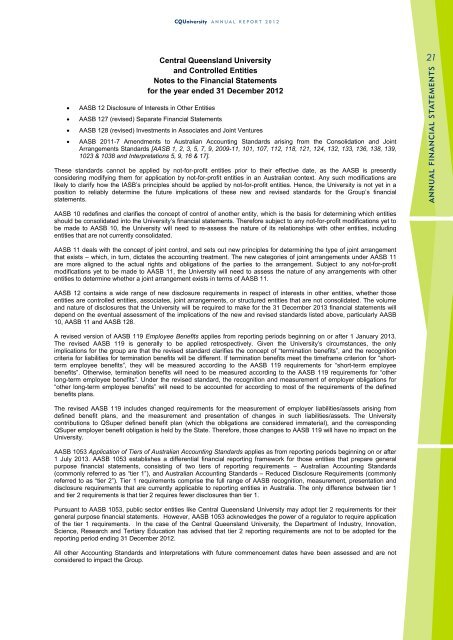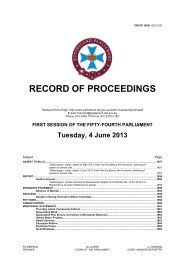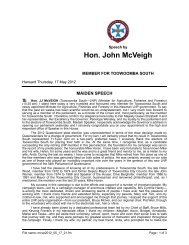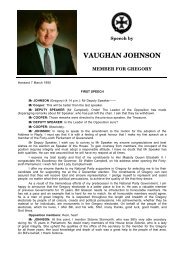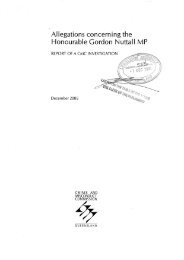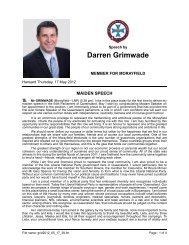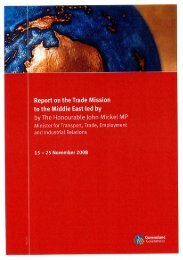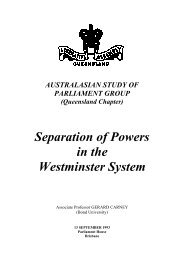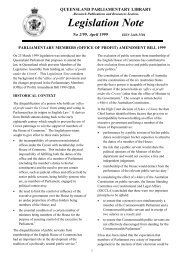CQUniversity Annual Report - Central Queensland University
CQUniversity Annual Report - Central Queensland University
CQUniversity Annual Report - Central Queensland University
You also want an ePaper? Increase the reach of your titles
YUMPU automatically turns print PDFs into web optimized ePapers that Google loves.
<strong>CQ<strong>University</strong></strong> ANNUAL REPORT 2012<br />
<br />
<br />
<br />
<br />
<strong>Central</strong> <strong>Queensland</strong> <strong>University</strong><br />
and Controlled Entities<br />
Notes to the Financial Statements<br />
for the year ended 31 December 2012<br />
AASB 12 Disclosure of Interests in Other Entities<br />
AASB 127 (revised) Separate Financial Statements<br />
AASB 128 (revised) Investments in Associates and Joint Ventures<br />
AASB 2011-7 Amendments to Australian Accounting Standards arising from the Consolidation and Joint<br />
Arrangements Standards [AASB 1, 2, 3, 5, 7, 9, 2009-11, 101, 107, 112, 118, 121, 124, 132, 133, 136, 138, 139,<br />
1023 & 1038 and Interpretations 5, 9, 16 & 17].<br />
These standards cannot be applied by not-for-profit entities prior to their effective date, as the AASB is presently<br />
considering modifying them for application by not-for-profit entities in an Australian context. Any such modifications are<br />
likely to clarify how the IASB’s principles should be applied by not-for-profit entities. Hence, the <strong>University</strong> is not yet in a<br />
position to reliably determine the future implications of these new and revised standards for the Group’s financial<br />
statements.<br />
21<br />
ANNUAL FINANCIAL STATEMENTS<br />
AASB 10 redefines and clarifies the concept of control of another entity, which is the basis for determining which entities<br />
should be consolidated into the <strong>University</strong>’s financial statements. Therefore subject to any not-for-profit modifications yet to<br />
be made to AASB 10, the <strong>University</strong> will need to re-assess the nature of its relationships with other entities, including<br />
entities that are not currently consolidated.<br />
AASB 11 deals with the concept of joint control, and sets out new principles for determining the type of joint arrangement<br />
that exists – which, in turn, dictates the accounting treatment. The new categories of joint arrangements under AASB 11<br />
are more aligned to the actual rights and obligations of the parties to the arrangement. Subject to any not-for-profit<br />
modifications yet to be made to AASB 11, the <strong>University</strong> will need to assess the nature of any arrangements with other<br />
entities to determine whether a joint arrangement exists in terms of AASB 11.<br />
AASB 12 contains a wide range of new disclosure requirements in respect of interests in other entities, whether those<br />
entities are controlled entities, associates, joint arrangements, or structured entities that are not consolidated. The volume<br />
and nature of disclosures that the <strong>University</strong> will be required to make for the 31 December 2013 financial statements will<br />
depend on the eventual assessment of the implications of the new and revised standards listed above, particularly AASB<br />
10, AASB 11 and AASB 128.<br />
A revised version of AASB 119 Employee Benefits applies from reporting periods beginning on or after 1 January 2013.<br />
The revised AASB 119 is generally to be applied retrospectively. Given the <strong>University</strong>’s circumstances, the only<br />
implications for the group are that the revised standard clarifies the concept of “termination benefits”, and the recognition<br />
criteria for liabilities for termination benefits will be different. If termination benefits meet the timeframe criterion for “shortterm<br />
employee benefits”, they will be measured according to the AASB 119 requirements for “short-term employee<br />
benefits”. Otherwise, termination benefits will need to be measured according to the AASB 119 requirements for “other<br />
long-term employee benefits”. Under the revised standard, the recognition and measurement of employer obligations for<br />
“other long-term employee benefits” will need to be accounted for according to most of the requirements of the defined<br />
benefits plans.<br />
The revised AASB 119 includes changed requirements for the measurement of employer liabilities/assets arising from<br />
defined benefit plans, and the measurement and presentation of changes in such liabilities/assets. The <strong>University</strong><br />
contributions to QSuper defined benefit plan (which the obligations are considered immaterial), and the corresponding<br />
QSuper employer benefit obligation is held by the State. Therefore, those changes to AASB 119 will have no impact on the<br />
<strong>University</strong>.<br />
AASB 1053 Application of Tiers of Australian Accounting Standards applies as from reporting periods beginning on or after<br />
1 July 2013. AASB 1053 establishes a differential financial reporting framework for those entities that prepare general<br />
purpose financial statements, consisting of two tiers of reporting requirements – Australian Accounting Standards<br />
(commonly referred to as “tier 1”), and Australian Accounting Standards – Reduced Disclosure Requirements (commonly<br />
referred to as “tier 2”). Tier 1 requirements comprise the full range of AASB recognition, measurement, presentation and<br />
disclosure requirements that are currently applicable to reporting entities in Australia. The only difference between tier 1<br />
and tier 2 requirements is that tier 2 requires fewer disclosures than tier 1.<br />
Pursuant to AASB 1053, public sector entities like <strong>Central</strong> <strong>Queensland</strong> <strong>University</strong> may adopt tier 2 requirements for their<br />
general purpose financial statements. However, AASB 1053 acknowledges the power of a regulator to require application<br />
of the tier 1 requirements. In the case of the <strong>Central</strong> <strong>Queensland</strong> <strong>University</strong>, the Department of Industry, Innovation,<br />
Science, Research and Tertiary Education has advised that tier 2 reporting requirements are not to be adopted for the<br />
reporting period ending 31 December 2012.<br />
All other Accounting Standards and Interpretations with future commencement dates have been assessed and are not<br />
considered to impact the Group.


